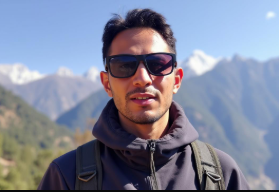Upper Dolpo Trek
Trip Type
Trekking In Nepal
Accomodation
Tea House
Destination
Nepal
Start Point
Kathmandu
Region
Restricted Region
Duration
22 Days
The Upper Dolpo Trek is a remote, challenging adventure located in Nepal’s far western region. This trek offers diverse landscapes, panoramic views of mountains. This trek takes you to Shey-Phoksundo National Park. which is the home of wildlife species like snow leopard, blue sheep, and diverse flora.
Seasonal Information:
Weather can influence your trekking experience so choosing the right season for the trek is crucial. The best season for this trek is autumn(september-november). In this season the temperature is mild and you can see the clear views of mountains. It is also a festive season so you can enjoy festivals like dashain, tihar in local villages. The landscapes are very vibrant which are best for photography. In spring(march-may) you can see the blooms of rhododendron, temperature is moderate and weather is ideal for trekking. Likewise the winter(december-february) season is less recommended for trek because the weather is harsh and there is possibility of snowfall so it may block the trails. Monsoon(June-August) is the greenery season due to rainfall. High chance of slippery trails and landslides. You can see the scenic beauty and refreshing landscapes.
Cultural and Natural Insights:
Culturally, the trek passes through traditional Tibetan-influenced villages. You can explore the ancient monasteries, mani walls, prayer flags. You can witness the lifestyle of people and experience their warm hospitality. Naturally, you can experience the diverse landscapes from lush valleys to high altitude trails. You can enjoy the view of Kanjiroba, Kagmara along with other peaks. You can explore the mesmerising Shey-Phoksundo National Park which is the home for wildlife like blue sheep, snow leopards, and various bird species. You can explore Phoksundo Lake which is known for its emerald waters and scenic beauty.
Preparation Guide:
-
For Physical fitness: This trek is suitable for beginners also with many ascents and descents . So you need to be physically fit to walk for long hours.
-
For packing list:
-
For clothes, you need layered clothing like thermal, jackets, base layer, fleece.
-
For footwear, waterproof trekking boots with good grip is needed.
-
For gear, you need trekking poles, headlamp, and a day pack.
-
Sunscreen, power banks, sunglasses, water purification tablets are required.
Sustainability and Responsibility:
The ecosystem of Everest region has been significantly impacted by increasing tourism. Trekkers have some responsibilities towards the environment to preserve the beauty of the Himalayas for our own good and for the future generation. Here are some ways to practice environmental responsibility:
-
You can carry garbage bags with you or dispose of trash in designated areas.
-
Avoid using single use plastic water bottles.
-
Choose accommodation that follows sustainable practice.
-
You can purchase local goods to uplift/ support the local economy.
-
Avoid picking rare plants that take long to grow and respect wildlife and their habitat.
-
Travel in groups to reduce ecological strain.
Modern Travel Expectation:
Now trekkers seek balance between adventure and the outside world while in trek to be connected. Here are some expectation of modern traveller that we try to meet:
-
Internet access as wifi is available at teahouses.
-
Comfortable accommodation due to upgraded teahouses and hygiene facilities.
-
Available expanded menu of options including pizza, pancakes, and vegetarian dishes.
-
Sustainable and ethical practices as sustainable practice of waste management and using renewable energy.
-
Customizable trekking experience for solo travellers or groups for more fun in adventure.
Why Choose Nepal Outdoor Expeditions?
At Nepal Outdoor Expeditions, we believe a great trek is more than reaching a destination, it's about the stories you collect, the connections you make, and the landscapes that leave you in awe. With our experienced team handling every detail, from logistics to local insights, you can fully enjoy the journey. Whether you’re stepping onto the trail for the first time or seeking your next big adventure, we’re here to make it effortless, meaningful, and truly unforgettable.
Treks You Might Like:
Highlights of the Upper Dolpo Trek
-
You can explore the Shey-Phoksundo National Park.
-
You can witness the stunning Phoksundo Lake
-
You can witness the stunning views of peaks like Kanjibroba, Kagmara and Dhaulagiri range.
-
You can explore Crystal Monastery
-
You can explore Trans-Himalayan Salt Trade Route and the historic village of Dho Tarap.
-
You can explore and enjoy the culture of locals
Short Itinerary ( 22 days )
You arrive in Kathmandu, transfer to hotel. You can explore the city and prepare for the trek.
You’ll have a short domestic flight to Nepalgunj. You’ll spend the day exploring the local markets and rest for the remaining day. Altitude loss: 1250 m.
You’ll take a flight to Jhupal. After you reach Jhupal, you’ll start your trek to Dunai passing through terraced fields. Dunai is the headquarters of Dolpa. Distance: 8km, walking hours: 3-4, altitude gain: 325m, altitude loss: 660m.
You’ll follow the Bheri river and pass through deep gorges, forests, and small villages. Chhepka is a small settlement. Distance: 18km, walking hours: 6-7, altitude gain: 698m.
You’ll trek through a lush forest filled with pine and birch trees. You’ll pass through Rechi village and continue along the river before reaching Chunuwar. Distance: 14km, walking hours: 5-6, altitude gain: 342m.
You’ll hike uphill to a ridge. You can witness the stunning views of Phoksundo Lake. Phoksundo Lake is the deepest lake. Distance: 7km, walking hours: 4-5 hrs, altitude gain: 431m.
You can explore the Tshowa Gompa overlooking the lake or you can go for a short hike around the lake.
You’ll trek along the western shore of Phoksundo Lake on a rocky and challenging trail. You'll trek through isolated landscapes. Distance: 12km, walking hours: 5-6, altitude gain: 69m.
You’ll follow the river upstream. You’ll gain altitude towards Snowfields Camp. Distance: 9km, walking hours: 6-7, altitude gain: 720m.
You’ll ascend through Kang La Pass (5360 m), which is the highest point of the trek. You’ll descend through forests to reach Shey Gompa. It is an ancient monastery. Distance: 14km, walking hours: 7-8, altitude gain: 960m, altitude loss: 970m.
You’ll visit Crystal Mountain and explore the monastery. You can have a short acclimatization hike around the area.
You’ll ascend to Saldang La Pass(5200 m) and you’ll start your trek to Numgung village. Distance: 15 km, walking hours: 7-7, altitude gain: 810m, altitude loss: 770 m.
It is an easier trek through a wide valley which will lead to Saldang. It is the largest village in Dolpo. Distance: 10km, walking hours: 5-6, altitude loss: 527m.
You’ll walk through hills to reach Yangze Gompa. It is an ancient Buddhist monastery. Distance: 12km, walking hours: 5-6, altitude gain: 297m.
You’ll trek back to Saldang and continue your walk to Sibu along the Nagon river. Distance: 18km, walking hours: 6-7, altitude loss: 200m
You’ll walk uphill to the base of Jeng La Pass. You can witness the stunning mountain views. Distance: 12km, walking hours: 6-7, altitude gain: 900 m.
You'll climb to Jeng La Pass(5110 m). You can witness the stunning views of Dhaulagiri . Distance: 15km, walking hours:6-7, altitude gain: 210m, altitude loss: 910 m.
You’ll have a short and easy descent to Dho Tarap. Dho Tarap is a rich village with monasteries. Distance: 6km, walking hours: 3-4, altitude loss: 160m.
You’ll descend through gorge and pine forests followed by the Tarap river to reach Tarakot. Stay overnight at a tea house. Distance: 18km, walking hours: 7-8, altitude loss: 1503m.
You’ll have a final trekking day. You’ll follow Bheri river to reach Dunai and then you’ll gradually climb to Juphal. Distance: 15km, walking hours: 7-8, altitude gain or loss: 335m
You’ll have a flight back to Nepalhunj and then again fly back to Kathmandu. You can explore the city or rest for the day.
You’ll transfer to the International Airport for your departure concluding the trek.
Cost Includes
-
Cost of Domestic flights
-
Cost of Upper Dolpo Restricted Area Permit and Shey-Phoksundo Conservation Area Permit.
-
Standard meals during the trek
-
Accommodation in Teahouses.
-
First aid and medical service
-
Cost of Guide or porters.
Cost Excludes
-
International Airfare
-
Nepal Visa Fees
-
Cost of Travel Insurance
-
Cost of personal expenses
-
Extra accommodation in Kathmandu
-
Tips for guide or porters


.png)

